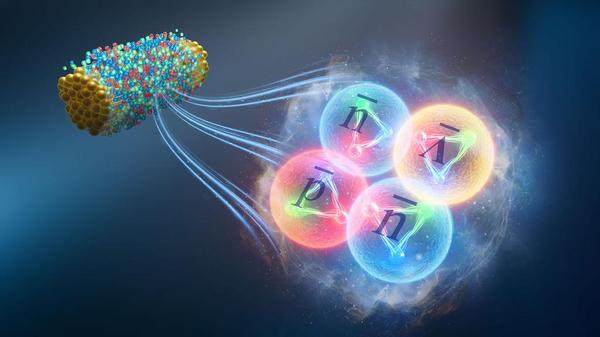
Physicists Create Heaviest Antimatter Nucleus Yet
Antimatter is one of science’s great mysteries. It is produced all around us for fractions of a second, until it collides with matter, and the particles annihilate one another. But what is it?
Antimatter is just like matter, except for one thing. Its particles have the same mass as ordinary matter, but an opposite charge. For example, an electron has a negative charge, so an anti-electron—called a positron—weighs the same, but has a positive charge.
Antimatter is a natural product of some types of radioactive decay and cosmic ray collisions, but it can also be made in particle colliders here on Earth. But making antimatter particles this way is difficult and expensive—let alone controlling them enough to create an entire anti-atom. NASA estimates that creating a gram of antimatter would cost about $62.5 trillion.
But why does antimatter matter? It may hold the key to understanding one of the universe’s biggest mysteries: why there’s something rather than nothing. Cosmologists say that during the Big Bang, matter and antimatter should have been created in equal amounts. But everything around us today is mostly matter, meaning either that there was an excess of matter created, or that matter and antimatter don’t quite follow the rules physicists expect.
Recently, scientists at Brookhaven National Laboratory’s Relativistic Heavy Ion Collider spotted 16 instances of the heaviest exotic antimatter nucleus observed to date: antihyperhydrogen-4.
To explore what this breakthrough means for antimatter research, SciFri producer Charles Bergquist talks to Dr. Jamie Dunlop, associate department chair for nuclear physics at Brookhaven National Laboratory.
Antimatter is just like matter, except for one thing. Its particles have the same mass as ordinary matter, but an opposite charge. For example, an electron has a negative charge, so an anti-electron—called a positron—weighs the same, but has a positive charge.
Antimatter is a natural product of some types of radioactive decay and cosmic ray collisions, but it can also be made in particle colliders here on Earth. But making antimatter particles this way is difficult and expensive—let alone controlling them enough to create an entire anti-atom. NASA estimates that creating a gram of antimatter would cost about $62.5 trillion.
But why does antimatter matter? It may hold the key to understanding one of the universe’s biggest mysteries: why there’s something rather than nothing. Cosmologists say that during the Big Bang, matter and antimatter should have been created in equal amounts. But everything around us today is mostly matter, meaning either that there was an excess of matter created, or that matter and antimatter don’t quite follow the rules physicists expect.
Recently, scientists at Brookhaven National Laboratory’s Relativistic Heavy Ion Collider spotted 16 instances of the heaviest exotic antimatter nucleus observed to date: antihyperhydrogen-4.
To explore what this breakthrough means for antimatter research, SciFri producer Charles Bergquist talks to Dr. Jamie Dunlop, associate department chair for nuclear physics at Brookhaven National Laboratory.













